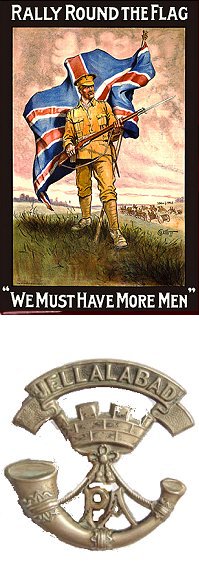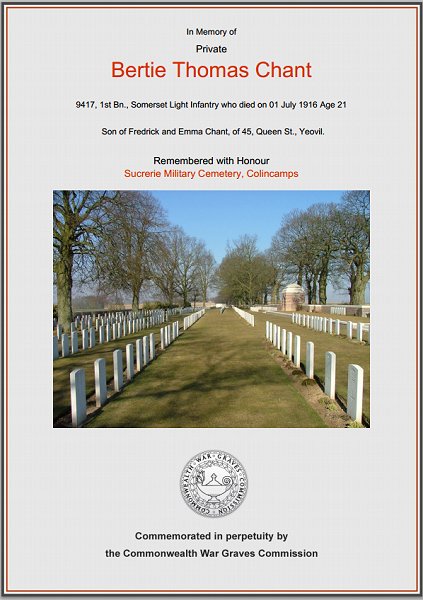yeovil at War
Bertie Thomas Chant
Killed on the first day of the Somme 'Great Advance'
Bertie Thomas Chant was born in Yeovil in 1895. He was the son of maltster's labourer Frederick Chant and his wife Emma. In the 1901 Census Frederick and Emma were listed at 8 Wellington Street with their three sons Frederick aged 10, Bertie aged 6 and Sydney aged 4. By 1911 Frederick and Emma had been married for 21 years, they had nine children of whom two died in infancy. In the census of this year the family were living at 45 Queen Street. Fredrick gave his occupation as mason's labourer while 16-year-old Bertie gave his occupation simply as a labourer.
 Around
1912 Bertie
enlisted in the
Regular Army at
Taunton (Service
No 9417) in the
1st Battalion,
Somerset Light
Infantry.
Around
1912 Bertie
enlisted in the
Regular Army at
Taunton (Service
No 9417) in the
1st Battalion,
Somerset Light
Infantry.
At the outbreak of war in 1914 the 1st Battalion was in Colchester, with 11th Brigade, 4th Division. The Battalion landed at Le Havre, France with the British Expeditionary Force (BEF) on 22 August 1914, in time to fight in the battle of Le Cateau during the retreat from Mons. The 1st Battalion, Somerset Light Infantry remained on the Western Front with 4th Division, throughout the war, suffering 1,315 losses.
Bertie Chant saw two years of almost continual fighting as he took part in all the following battles with the 1st Battalion of the Somersets.
In 1914 the 1st Battalion saw action at the Battle of the Marne, the Battle of the Aisne and at the Battle of Messines.
The First Battle of the Marne, fought from 5 to 12 September 1914, resulted in an Allied victory against the German Army. The battle was the culmination of the German advance into France and pursuit of the Allied armies which followed the Battle of the Frontiers in August, which had reached the outskirts of Paris. The counterattack of six French field armies and the British Expeditionary Force (BEF) along the Marne River forced the German Imperial Army to abandon its push on Paris and retreat north-east, leading to the 'Race to the Sea' and setting the stage for four years of trench warfare on the Western Front. The Battle of the Marne was an immense strategic victory for the Allies, wrecking Germany's bid for a swift victory over France and forcing it into a drawn-out two-front war.
The First Battle of the Aisne was the Allied follow-up offensive against the right wing of the German First and Second Armies as they retreated after the First Battle of the Marne earlier in September 1914. The offensive began on the evening of 13 September, after a hasty pursuit of the Germans. When the Germans turned to face the pursuing Allies on 13 September, they held one of the most formidable positions on the Western Front. Low crops in the unfenced countryside offered no natural concealment to the Allies but deep, narrow paths cut into the escarpment at right angles, exposing any infiltrators to extreme hazard. In dense fog on the night of 13 September, most of the BEF crossed the Aisne on pontoons or partially demolished bridges. Under the thick cover of the foggy night, the BEF advanced up the narrow paths to the plateau. When the mist evaporated under a bright morning sun, they were mercilessly raked by fire from the flank. Those caught in the valley without the fog's protective shroud fared no better. It soon became clear that neither side could budge the other and since neither chose to retreat, the impasse hardened into stalemate that would lock the antagonists into a relatively narrow strip for the next four years.
The Battle of Messines, fought between 12 October and 2 November 1914, was part of the 'Race to the Sea', the series of battles that decided the line of the Western Front. In the aftermath of the first Battle of the Marne, it was decided to move the BEF back north to Flanders, to shorten its supply lines back to the channel ports. The Battle of Messines was the official name for the fighting between the river Douve and the Comines-Ypres canal, but it merged into the battle of Armentières to the south and the first battle of Ypres to the north.
In 1915 the 1st Battalion, Somerset Light Infantry fought in the Second Battle of Ypres.
The Second Battle of Ypres, 22 April-25 May 1915, was a rare German offensive on the Western Front during 1915. It was launched with two aims in mind. The first was to distract attention from the movement of German troops to the eastern front in preparation for the campaign that would lead to the victory of Gorlice-Tarnow. The second was to assess the impact of poisoned gas on the western front. Gas had already been used on the eastern front, at Bolimov (3 January 1915), but the tear gas used there had frozen in the extreme cold. At Ypres the Germans used the first lethal gas of the war, chlorine. The gas was to be released from 6,000 cylinders and would rely on the wind to blow it over the allied trenches. This method of delivery controlled the timing of the attack – the prevailing winds on the western front came from the west, so the Germans had to wait for a suitable wind from the east to launch their attack. The line around Ypres was held by French, Canadian and British troops. The attack on 22 April hit the French lines worst and, not surprisingly, the line broke under the impact of this deadly new weapon. The gas created a gap 8,000 yards long in the Allied lines north of Ypres. The success of their gas had surprised the Germans who didn’t have the reserves to quickly exploit the unexpected breakthrough, allowing enough time to plug the gap with newly arrived Canadian troops. During the battle the British, French and Canadians suffered 60,000 casualties, the Germans only 35,000.
In 1916 the 1st Battalion moved south and were in action during the Battles of the Somme.
The Battle for the Somme has a unique place in British military history. Haig was in the middle of preparations for a British offensive but came under strong pressure to mount an attack due the French commitment to the Battle for Verdun, a city which held an important place in the nation's psyche and that the Germans had attacked in February 1916. Any Allied offensive would therefore have to be carried mainly by the British. Haig was therefore forced to undertake an offensive near to where the British and French lines met, near Bray-sur-Somme in Picardy, although he would have preferred to attack further north and to have had longer with which to prepare his new army. The battlefield was bisected by both the Albert – Bapaume Road and the River Somme, and was a series of gentle chalk ridge lines into which the Germans had dug a series of well-prepared fortifications. Haig's plan called for Rawlinson’s Fourth Army to achieve a breakthrough in the centre after which Gough’s Reserve Army (later renamed the Fifth Army) would exploit, roll up the German defences and capture Bapaume. Allenby's Third Army would undertake a diversionary attack on Gommecourt, which lay to the north. The massive preparatory bombardment, meant to destroy the German defences started on 24 June 1916 at 06.00. Over 1.7 million shells were fired but a high proportion, some 30 percent, failed to explode as the Ministry of Munitions had abandoned any semblance of quality control in order to be able to produce the quantities needed in time. Tunnelling companies dug hollowed out chambers underneath key German strongpoints and filled them with explosives. The shelling had started on 'U' Day and was meant to go on until 'Z' Day, which was 29 June 1916 but heavy rains caused the approach roads, trenches and crater ridden No-Man's land too muddy and so the assault was postponed until 1 July.
Just after dawn on 1 July 1916, the first British wave clambered out of their trenches and started to make their way towards the German frontline. As they did, seventeen enormous mines were detonated and the barrage moved forward. The infantry followed behind and although there were local gains on the first day, generally things looked bleak. The British suffered 57,470 casualties (19,240 killed and 2,152 missing) which included Private Bertie Thomas Chant, who was shot in the chest and died in the assault. He was just 21 years old.
The British Army suffered, over the course of the entire 142-day campaign, some 415,000 casualties. The Somme campaign involved some twelve separate battles and finally came to an end on 18 November 1916.
The Western Gazette reported on 4 August 1916 "Mr and Mrs Chant, of 45 Queen Street, having received no news of their son, Private B Chant, of the Somerset LI, since the first day of the Great Advance, wrote to the Record Office and have been informed that he is missing. Private Chant, who is 21 years of age, has been in the army four and a half years, and has been at the Front since the commencement of hostilities."
On 1 September 1916 the Western Gazette reported "Mr and Mrs Chant, of 45 Queen Street, Yeovil, recently received the sad intelligence from the War Office that their second son, Private B Chant, of the Somerset LI, was killed in action on the first day of the great advance. Private Chant was previously reported missing. Accompanying the notification was a Royal message of sympathy. In a letter received by the bereaved parents from one of his comrades it was stated that he was shot through the chest just after the attack, and death was almost instantaneous. Private Chant who was 21 years of age had been in the Army four and a half years. A letter received from the Sergeant-Major of the Company stated that Private Chant had been killed on the 1st July during an attack on the German trenches. His body was recovered and buried in the military cemetery. Much sympathy is felt for the parents who have two other sons serving, one in India and the other in France."
Bertie was interred at Sucrerie Military Cemetery, Colincamps, Somme, France, Grave I.D.26, and his name is recorded on the War Memorial in the Borough.
gallery

The Commonwealth War Graves Commission certificate in memory of Bertie Chant.